|
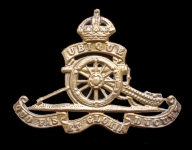
179275
Lieutenant
Lloyds, Arthur Douglas
Known as Douglas
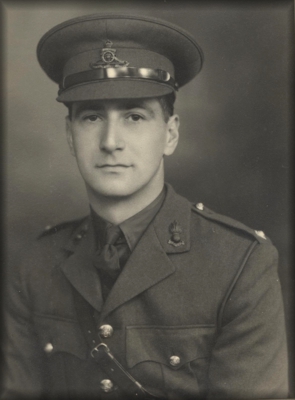
1907/11/13 - Born at Henley-on-Thames
Son of Arthur Richard and Mary Godwin Lloyds
1939/09/19 - Enlisted
Royal Artillery
78/35 L.A.A. Regiment
Japanese PoW
1942/03/08 - Captured Java
Tandjong Priok Camp
Commander Col. C.M. Lane
PoW No. 2342
Japanese PoW Card - Side One
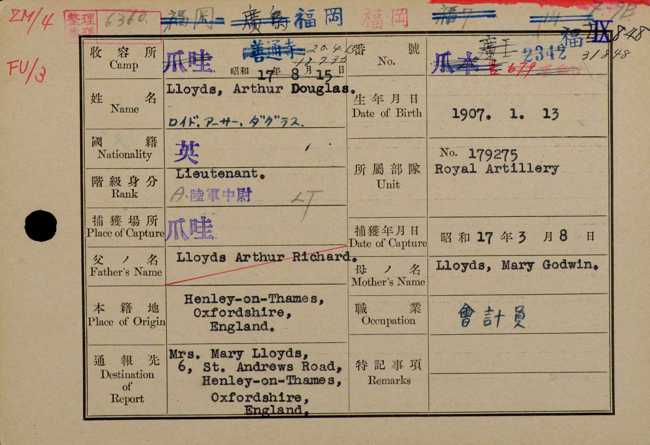
Japanese PoW Card - Side Two
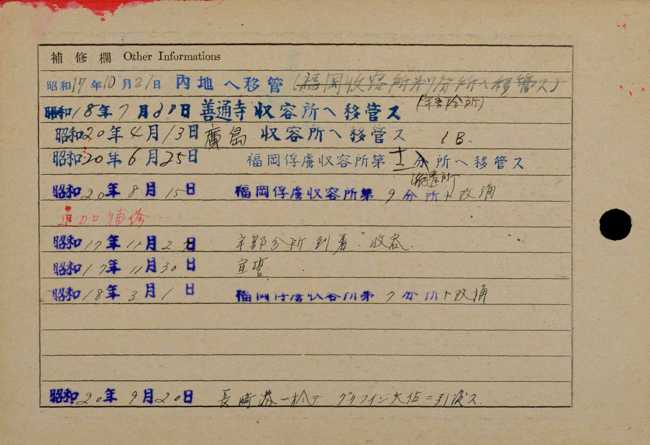
Taken from Affidavit by Eric Kenneth Scott
1942/10/19 - Col. C.M. Lane M.C., 10/15 Punjab Regt.,Senior British Officer P.O.W., Tanjong Priok, Batavia, was instructed by the Japanese Commandant, Tanjong Priok P.O.W. Camp to draft 1000 ( 90 Officers and 910 O.R.s approx ), for departure for an unknown destination on the 21st October.
Immediate representations were made to the Japanese Authorities that, with the prevalence of malaria, dysentery, beri-beri, dengue, malnutrition, etc., in the camp, the majority were not in a fit state to travel. The worst sick cases among those drafted were inspected by the Senior British Medical Officer, Lt.Col. Mazie, R.A.M.C. and at a later stage by a Japanese Medical Officer from Batavia.
1942/10/21 - Substitutions were made where possible, but even so, when the draft assembled, there were many stretcher cases and some 10/20 % of the personnel collapsed on the march to the Docks. At the Tandjong Priok Docks the party was joined by a draft of 300 R.A.F., under command of Wing Commander Frowe, and 500 R.A. personnel under command of Lt. Col. Saunders R.A.
1600 hours - This total of 1800 embarked on the thirty year old, 5,000 ton "Yoshida Maru" and were crammed down the four hatchways. Wing Commander Frowe and Lt.Col. Saunders' parties were accommodated below the forward hatches with some seventy Japanese personnel who had taken the "best" of the accommodation for themselves and the Tandjong Priok party of 1000 were crowded together so tightly aft that it was impossible to lie down and those immediately under the hatchways, which were unprovided with tarpaulins, were soaked to the skin every time it rained during the voyage. There were 16 deck latrines forward and 8 aft, also 2 small water tanks forward and 2 aft.
1942/10/22 - The Yoshida Maru sailed from Batavia. Throughout the voyage three meals of rice and fish soup were served daily. Under these conditions there was an immediate increase in sickness and an emergency hospital was formed on the upper deck under the shelter of a leaky tarpaulin. No blankets were provided, nor were any medical supplies of any description.
1942/10/25, 1300 hours - Yoshida Maru arrived at Keppel Harbour, Singapore.
1942/10/26 - All personnel were ordered ashore for a hosedown on the dock side under the supervision of Japanese guards. All personnel were then marched to the roadside where they were obliged to take down their trousers and a glass rod was inserted in each man's anus in full public view. All were then returned to the "Yoshida Maru."
This is a Java Mystery Party 2, not named as as the PoWs did not go to Changi but stayed on the Yoshida Maru.
1942/10/28 - Wing Commander Frowe was instructed to draft 200 of his men to join Lt. Col. Saunders' party of 500 and transfer to another ship. Fourteen of the more seriously sick from Tanjong Priok Camp were then transferred to Singapore Hospital.
1942/10/29, 1400 hours - The remaining 1086 disembarked and were disinfested. During the day a further 19 went sick and were sent to shore hospital and 14 replacements were received from Changi P.O.W. Camp, making a total of 1081.
1942/10/29, 1900 hours - The 1081 embarked on the S.S. "Singapore Maru", 5,200 tons, built in 1904, the officers, 96 in number, being in this instance, segregated in the aft hold for the better maintenance of discipline. The general arrangements were similar to those on the "Yoshida Maru". Forward were accommodated Japanese troops, who spread themselves at the expense of the prisoners, and forward were 16 deck latrines, ( 8 for prisoners ), and four small water tanks, ( two for prisoners ). Aft were 8 deck latrines, two water tanks and the galley. Three meals of rice and fish soup were provided daily and hot water for drinking three or four times per day. There were two small lifeboats, four rafts and no life-belts for P.O.Ws.
1942/10/30, 1000 hours - The "Singapore Maru" sailed for Japan and by the 2nd of November sickness had increased to such an extent that the establishment of a hospital on the aft hatch cover became necessary. The required accommodation was grudgingly given, as was the 1 lb Mag. Sulphate and a few aspirin and quinine tablets. Two men died almost as soon as the "hospital" was established.
1942/11/03 - The "Singapore Maru" hove to off Cap St. Jacques, where, as Senior Officer, I made the strongest possible representations to the Japanese Commanding Officer, Lieut. Moriyama, regarding the state of affairs on board and demanded the immediate removal of all sick to Saigon and the sending of a radio report to Batavia to prevent the further shipment of P.O.W.s under such intolerable conditions. The same afternoon the ship sailed without any action being taken to improve conditions aboard.
Sickness was now increasing at such a rate and the weather deteriorating to such an extent that the accommodation under the aft hatch had to be cleared of troops and the sick transferred to the space vacated. No amenities of any sort such as mats, mattresses, blankets, etc. were provided and the sick lay on the bare steel deck. With difficulty some wooden buckets were secured for use as hospital latrines. A small quantity of newsprint was provided as toilet paper, but was soon exhausted and, as there was only sufficient water to permit of washing the hands once a day, personal hygiene was impossible and disease spread rapidly in consequence. Deaths continued up to the arrival of the "Singapore Maru" at Takow, Formosa.
1942/11/13 - At Formosa 8 bodies were sent ashore for cremation, the harbour authorities refusing to permit them to be buried at sea. A list of 100 seriously sick was compiled and a request for their immediate removal to shore hospital was submitted, but twenty-one only were put ashore.
At Takow, in spite of all protests, accommodation was to be found for a further 400 Japanese troops. The upper decks in all holds were cleared and the thousand odd P.O.W.s crammed down in the bottom of the holds and on the sand ballast in the space below the holds. The "hospital" was also transferred to the bottom of the aft hold. All Japanese troops were provided with clean mats to sleep on. P.O.Ws. slept on the steel decks or the sand ballast.
1942/11/15 - The "Singapore Maru" left Takow and the same day anchored off the Pescadores, where she remained until the 18th. A further seven were buried at sea the same evening. Two hundred bismuth tablets were then issued to Dr. Liddell, the R.A.F. doctor on board, by the Japanese Authorities.
Proceeding Northwards the weather worsened and the cold increased to the great discomfort of those, the majority, who were in possession of tropical clothing only, and no blankets. The deck latrines, damaged by heavy seas, leaked badly and sprayed infected excreta over the decks, while below decks, the hospital, being unable to cope with any more sick, sub-hospitals were established in each hold. Latrine buckets were set up in the holds but some were so weak by this time as to be unable to use them and de-faecated in their mess tins or where they lay.
1942/11/24 - By the time the ship anchored off Moji approximately 700 were suffering from some sort of sickness or other.
1942/11/25 - The ship went alongside and the Japanese troops disembarked. This left the stores unguarded and the same night they were raided by British personnel. An enquiry was instituted by the Japanese Military Police on discovery of the theft on the following day, but the urgent necessity to disembark appeared to cut these proceedings shorter than was expected. As Senior British Officer on board I was held responsible and threatened with shooting, while several officers were referred to as "uncivilised beasts" by the English speaking Japanese Officer from Fukuoka, who was in charge of disembarkation. A hygiene squad came aboard and sealed all latrines and inserted a glass rod in the anus of each P.O.W. ( a test for dysentery we were told ), but did nothing for the 280 seriously sick who were left on the ship after thirty of the hospital sick had been taken ashore for treatment in Moji, and the remaining 677 mobile P.O.Ws disembarked for splitting up into groups for transport by open barge to Coal Mines in the vicinity.
Of the fate of the 280 who were left on board in the care of three Dutch doctors and six Medical Orderlies it is believed that the majority succumbed within a few days.
The 677 mobile PoWs were left standing on the dock, in subzero temperatures, dressed in tropical kit, for several hours and without food were eventually split into one group of 170 and three groups of 169 each. The group of 170 and proceeded to Fukuoka No. 7 Camp, Ube, where a further 17 died from the effects of the voyage. All sufferred from scurvy for several weeks.
1942/11/27 - Held at Yahata Provisional PoW Camp, Ube Branch Camp
Commander Lt-Col. Scott
PoWs work was Coal Mining- mine was in nearby hills in Okinoyama, a suburb of Ube
1943/01/01 - Renamed Fukuoka PoW Camp Ube, Branch Camp
1943/03/01 - Renamed Fukuoka 7B Camp
1943/07/29 - Transferred to Zentsuji Camp with 5 other officers
Commander Captain O.L. Gordon, R.N.
PoWs work was Stevedores at Sakaide Rail Yards and the Port of Takamatsu (Nippon Express Co.)
This was a show camp" for propaganda purposes. Contained mostly officers
1945/06/25 to Fukuoka 9B PoW Camp, Miyata, Japan
Commander W/Cdr. G. Matthews, RAF
New PoW No. 31848
PoWs Work was Coal Mining
1945/09/20 - Liberated Fukuoka 9B (Miyata Machi, Kurate Gun Fukuoka Ken)
Liberation Questionnaire - Filled in by Douglas
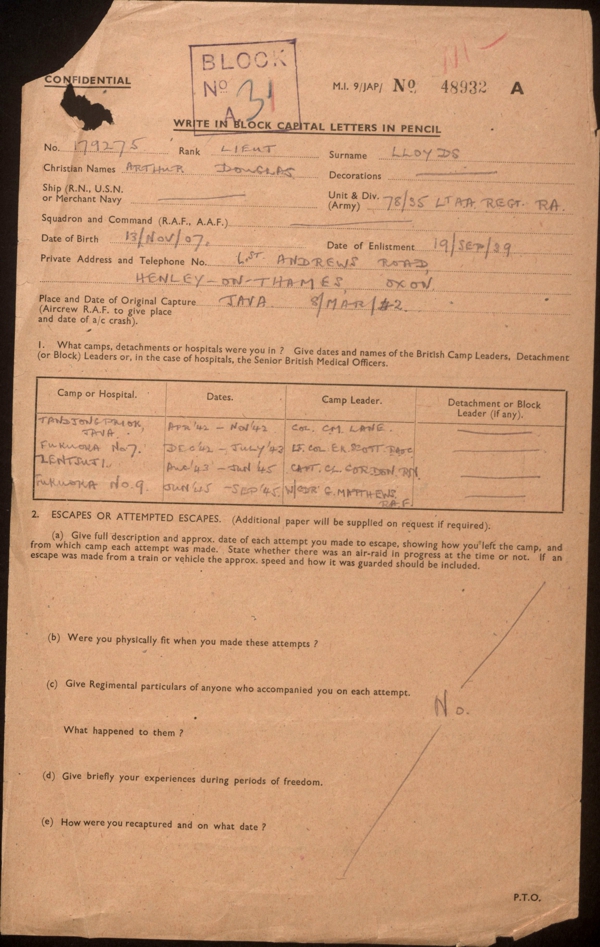
Information
Tim Lloyds
Java Index
Hell Ship
Affidavit by Eric Kenneth Scott
Fukuuka 9B - Roger Mansell
KEW:- WO 361/2009, WO 361/1254, WO 361/2186, WO 392/25, WO 345/32, WO 392/25, WO 361/2186, WO 361/2061,
|